どうして秋に紅葉するの?
Ashley Chen が 2020 年 11 月 24 日 に投稿  この条件に一致する単語はありません
この条件に一致する単語はありません- v.i.~歳になる;(変って)~になる : 変化する
- v.t./i.曲がる;向きを変える
- n.(道路の)曲がり角;(順番に回ってくる)担当 : 当番;順番;(予期せぬ突然の)変化
- v.t.(ものを)ろくろ(旋盤)にかけて作る
- v.t.着替える;両替する;取り替える;変える : 変わる;乗り換える
- n. (c./u.)着替えの服一式;小銭;おつり;変化 : 変更
US /ˈɪnstənt/
・
UK /ˈɪnstənt/
- adj.(飲食物が)インスタントの;すぐの : 即時の
- n.瞬間
- n. (c.)罠;一頭馬でひかれる馬車;トラップ;口;抜けられない状況
- v.t.罠にかける;人が動けないようにする;逃れないようにする;騙す;(抜き差しならぬ状態に)追い込む
エネルギーを使用
すべての単語を解除
発音・解説・フィルター機能を解除
